Marathon in the Chinese Far-West, Book 6
Taipei – Beijing (A333 - Air China) The Great Wall from the sky in French here in English there
Beijing – Urumqi (B752 - China Southern) Beijing by night in French here in English there
Urumqi – Kashgar (E190 - China Southern) Invalid boarding pass in French here in English there
Hotan – Urumqi (B738 - Air China) Crossing the Taklamakan in French here in English there
Urumqi – Dunhuang (E190 - China Southern) Winglet story in the desert in French ) here in English there
Dunhuang – Urumqi (E190 - China Southern) Two days after the storm in French there YOU ARE HERE
Urumqi – Shanghai (A320 - Juneyao Airlines) Single aisle across China in French here in English there
Shanghai – Taipei (A343 - Air China) 675 km in a 343 in French there in English there
This FR is nearly entirely in the desert. A desert is boundless rock and sand. Go and get yourself a coffee if your bandwidth is weak, because this is again a longish FR, like the three quarters of an hour drive from our last visit site to the airport. But I promise there will be fewer winglets than on the way in.

We eventually reach the Dunhuang oasis, and to this bilingual Chinese English sign, because we are not in Xinjiang, but very close to its limits, in the Gansu province.

The terminal is in mint condition, next to the road, with a rather small parking lot
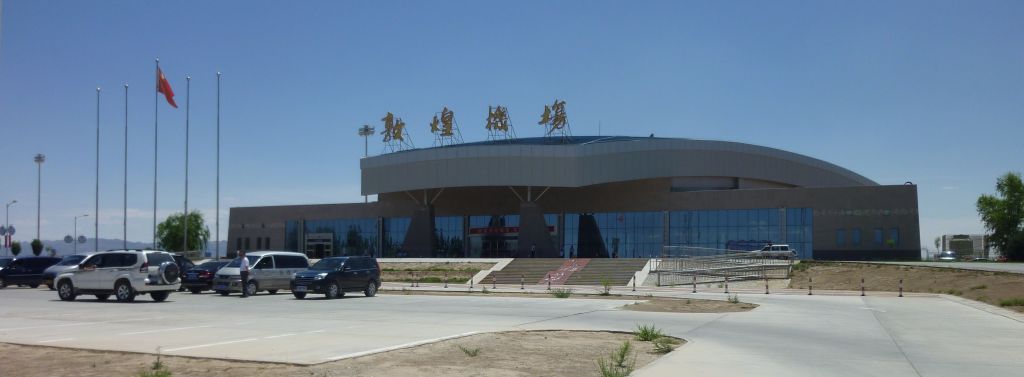
No mistake, we are indeed at Dunhuang airport.

Since our driver considered that we did not have enough time to reach the Han’s Great Wall (built in the second century BC, unlike the one which can be seen in the vicinity of Beijing), we are very much ahead of time, so I could just as well look at the surroundings.
Unfortunately, DNH is nowhere near entering China’s Top 10 plane spotter friendly airports’ list, because really nothing has been done to improve the view on the tarmac.
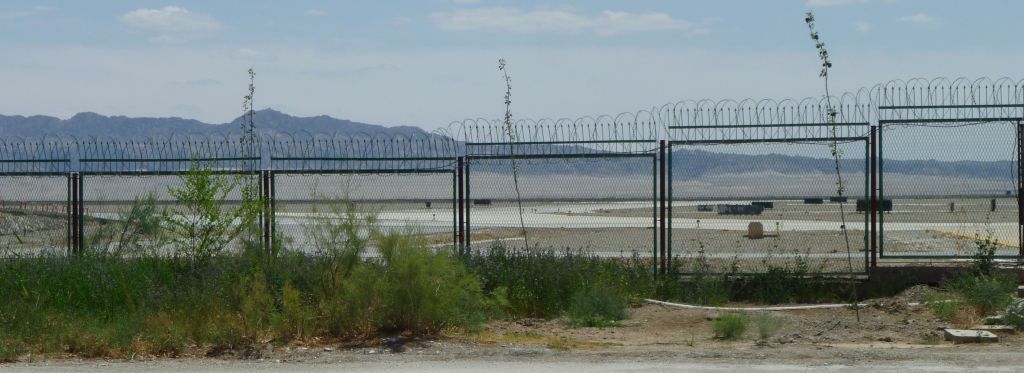
The tarmac is actually as empty as the desert in the background. Further away, there is the old control tower. I wish I had found an opened door to climb in it.

I eventually found this Cessna 208 parked in a remote area

The same, just before boarding.
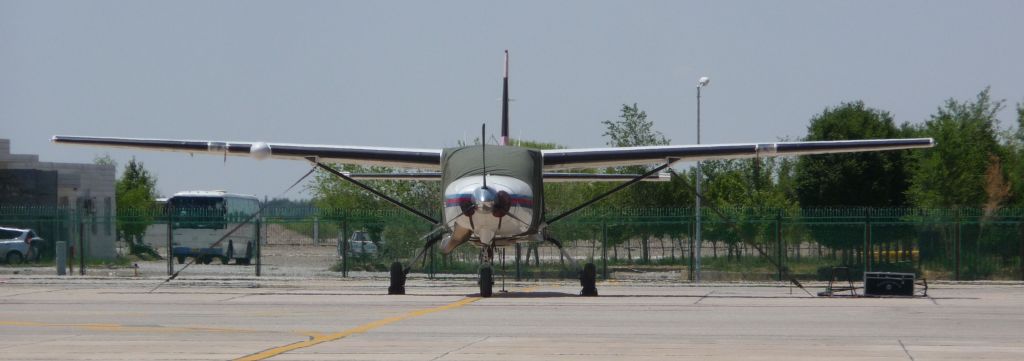
And slightly from profile.
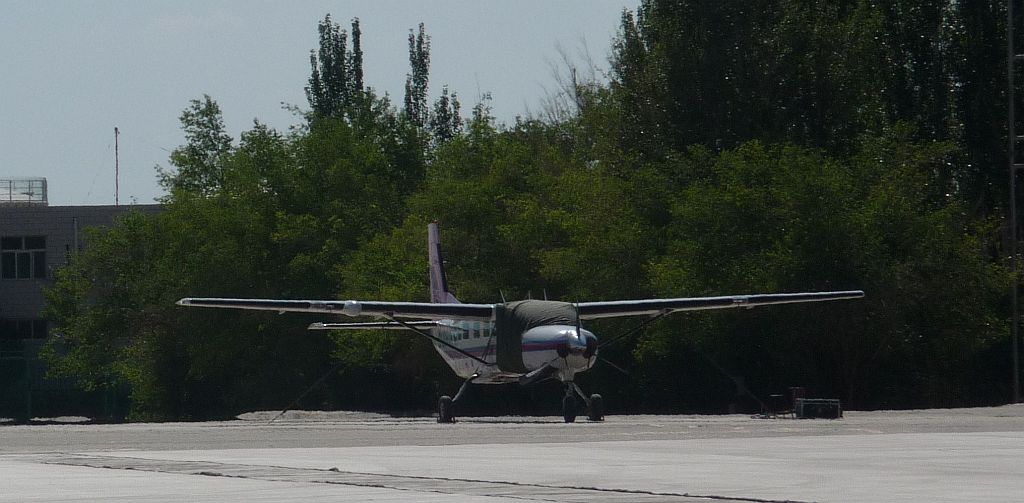
Actually, I mostly saw it like this, and that is how I saw its registration number B-3641 which confirmed its identification.

All this is not fascinating, and I return to the terminal, cutting through the sports ground of the airport’s employees.

On the way to the Mogao grottoes, I also saw the landing lights, which are completely enclosed in a barbed wire fence, to prevent anybody from stealing one to light up his car park.


There is a small plane spotting spot next to the terminal, with the same fence, but the advantage of a small camera is that its lens can make it through the fence.
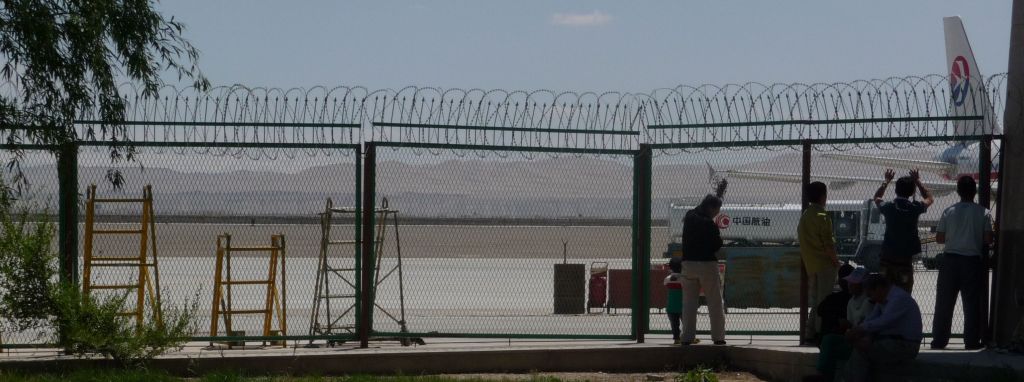
This allows me to take a picture of the China Eastern A320 which just landed and will leave to Shanghai Pudong by way of Xi'an. The industrial zone of the airport in the background is as busy as that of Hotan.


The same, from the inside of the terminal, landside
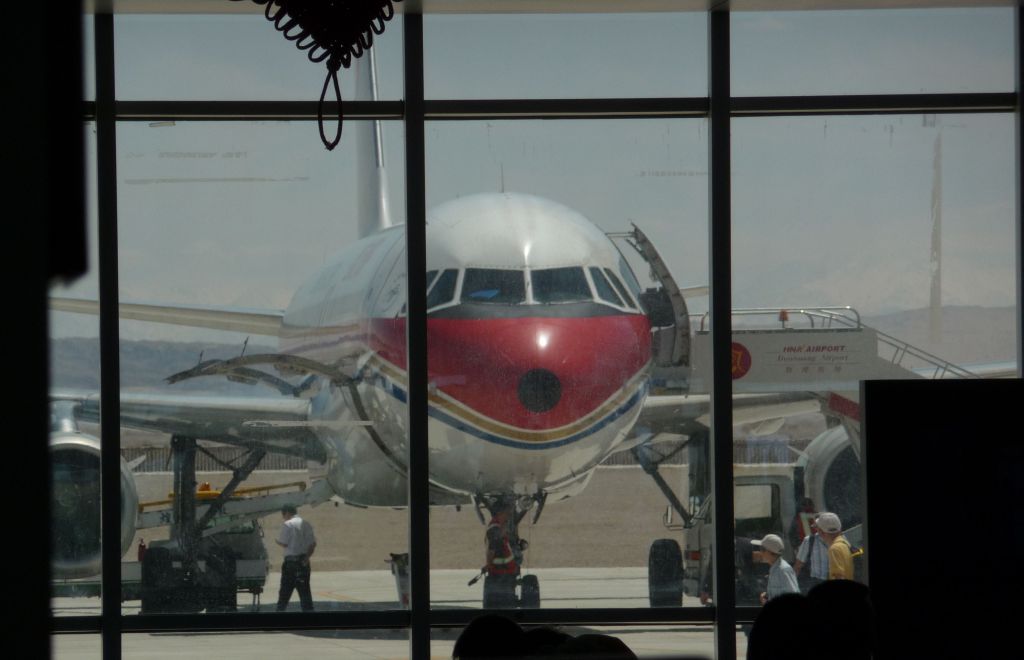
You must realize that DNH has a very intense traffic: three flights in the morning, three in the afternoon, it is like a permanent anthill. Ants leaving to PVG via XIY are going through the security check here…

… under the display where all the afternoon’s flights are not listed, to avoid overloading it.

Checking-in will have to wait, because the counters closed when flight MU2216 was closed too.

A peek meanwhile at the toilets which are spot clean, because continuously cleaned by an employee who seems never to stop.

And urinals decorated with rather vulgar drawings.

This is a more or less general view of the landside area, where there is no dearth of seats

The previous picture is taken approximately from the cafeteria which marks the landside left extremity.

At the other end, a bookstore where half of the books are devoted to the Mogao Caves, the Dunhuang tourist attraction.
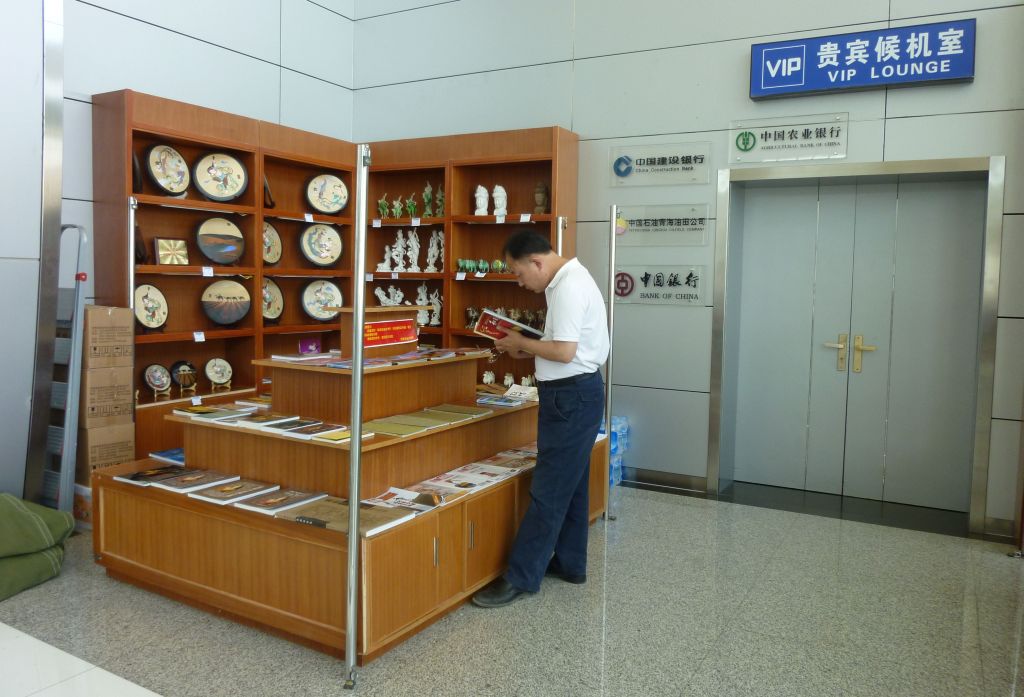
Some are even in English; books in English are very unusual in a Chinese airport.

Checking in starts at ETD-60’, without any rush


Check-in on the flight to Urumqi appears to be in a narrow time frame from 15:27 to 15:27.
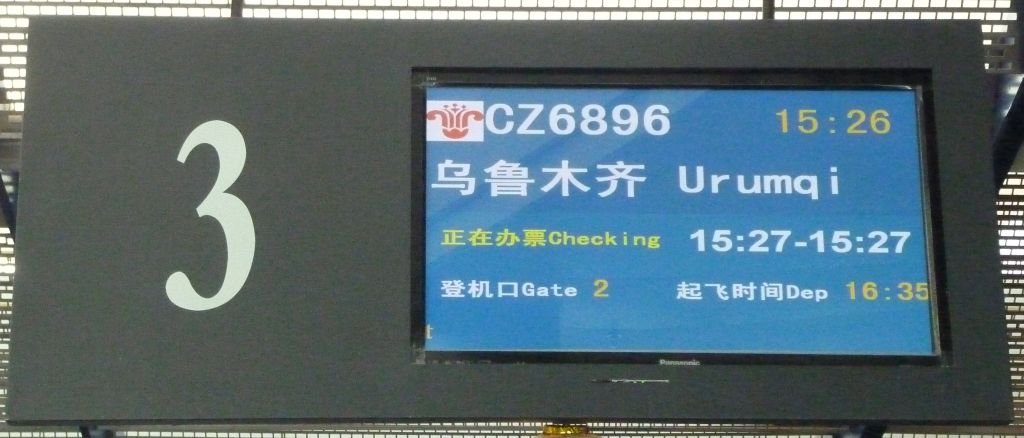
No, I do not have any prohibited item, and no, I do not have any diplomatic Xindai (« diplomatic pouch » was not in the translator’s dictionary)

Strangely, having asked to have a window seat, we have two window seats behind each other. Maybe we’ll be able to change once on board to sit next to each other; a 2+2 layout is ideal for that.

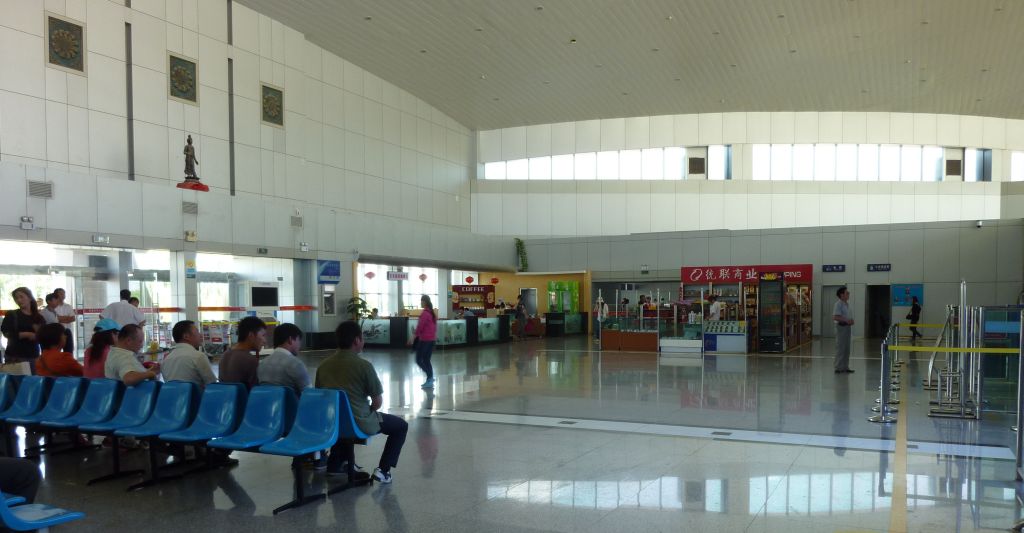
The security check is less stringent that in Xinjiang we are in the province of Gansu, which did not have ethnic riots. There has been self-immolation of Tibetan monks in the east of the province, though, that the Chinese censorship strictly prohibits mentioning in the media. The FR will not help the referencing of this website by Baidu, the Chinese 100% politically correct search engine.

Plane spotting from the airside boarding room is as fruitless as the desert itself.

The flight is announced on time

But nothing happens, and less than ten minutes before ETD, there is a trilingual (Mandarin / English / Japanese) announcement: due to the late arrival of the aircraft (which indeed has not arrived yet) and to air traffic control (certainly not that of the empty skies of DNH), the flight is delayed one hour. A number of passengers sigh with resignation.
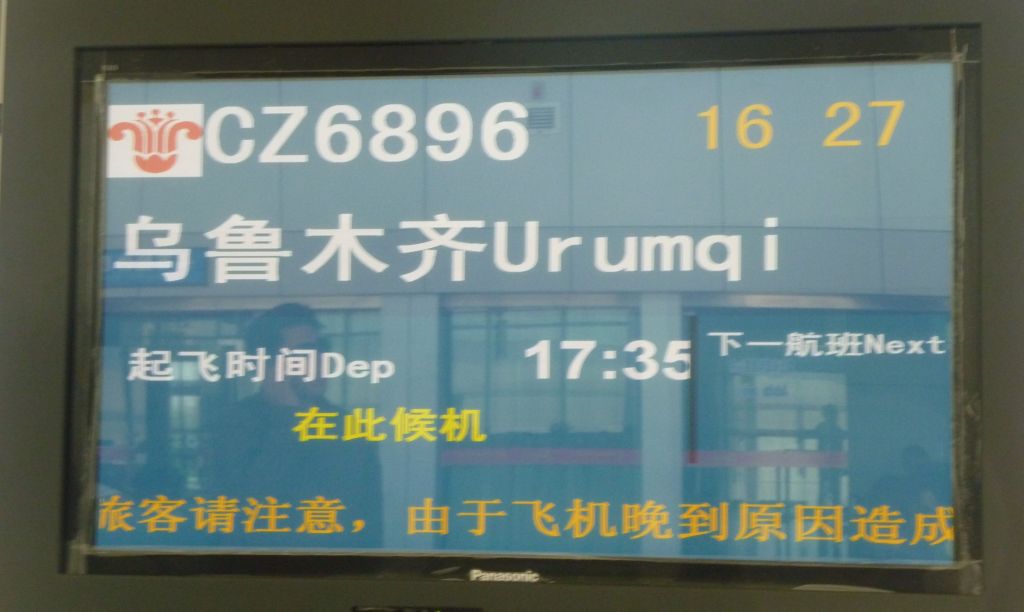
There is very hot water for thirsty passengers, but no cold water, because the Chinese consider that cold water is bad for your health.

And when the water bottles are empty? You only need to ask an employee, who goes and gets more from a room accessible from the tarmac.

Still nothing at the boarding gate
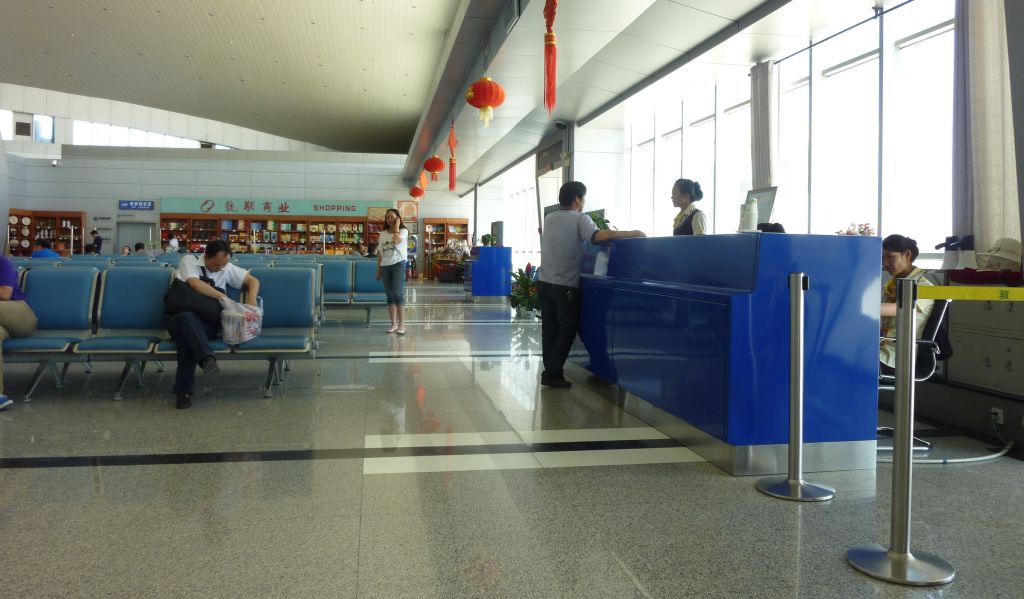
Note at the far right the equipment of the airport staff: fetching ultra light fabric hats for sun protection and loud speakers.
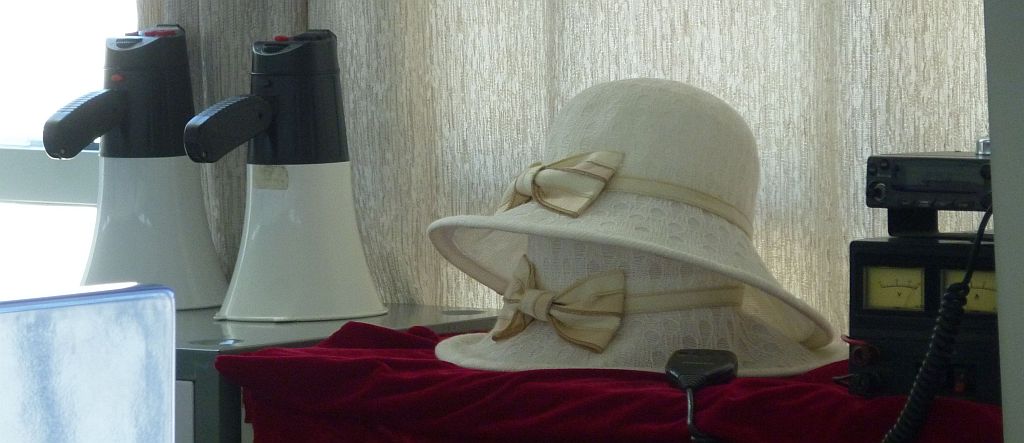
The E-190 from XIY lands at last




The mobile stairs approach

… on this tarmac which is still completely full of nothing (the following pictures were taken through a rather dirty window).

All passengers from XIY leave the aircraft
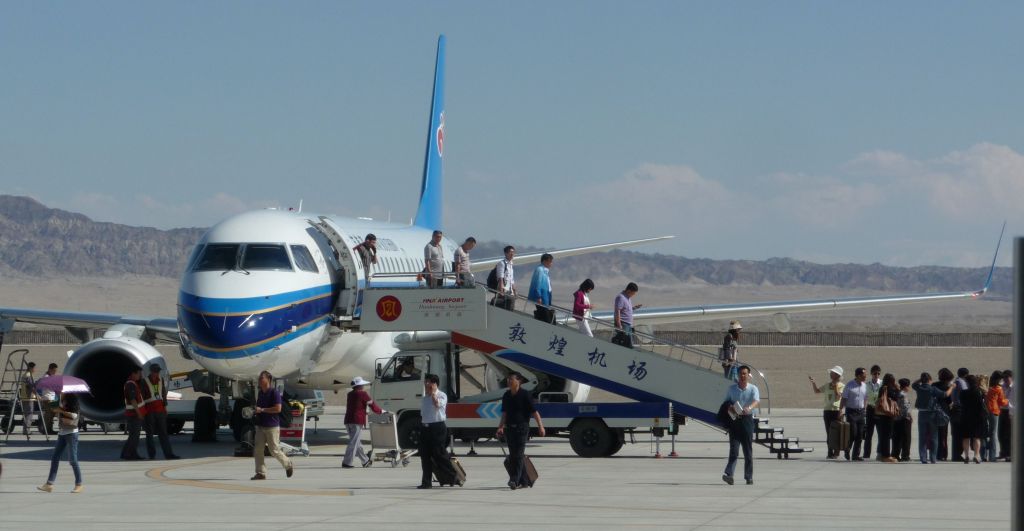
Those terminating their trip here go towards the left on this picture; those who continue towards Urumqi go to the boarding room where the passengers checked in DNH are waiting. On the right, an employee repeats these instructions with a loudspeaker.

An employee ticks the names of the passengers from XIY off a list. It took some time to an elderly passenger to understand that he should go to the other (exit) gate.
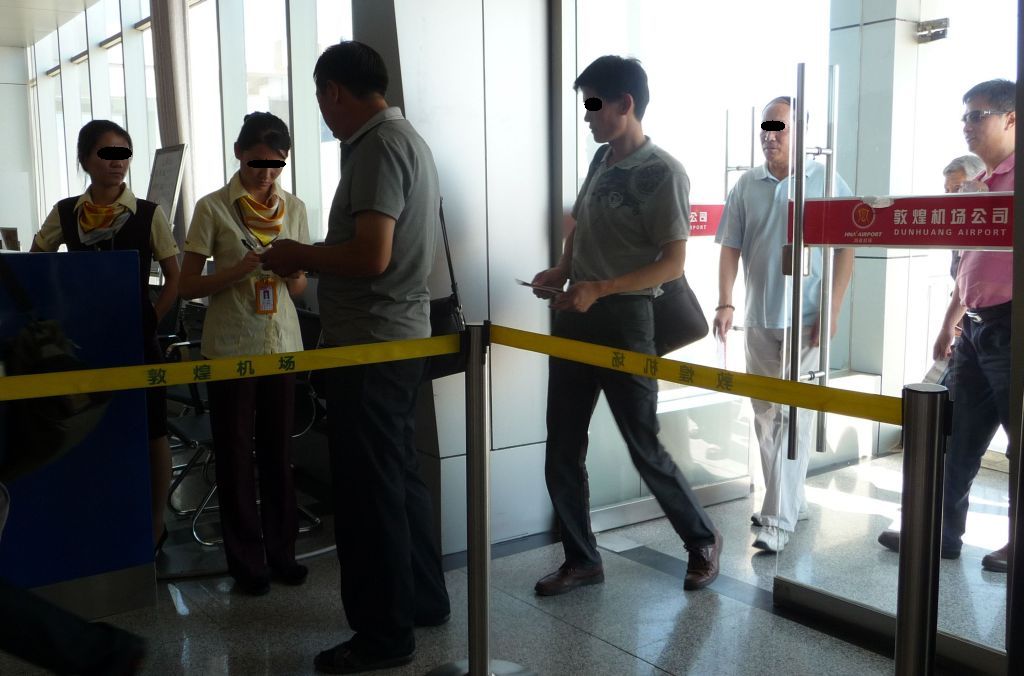
Boarding at last
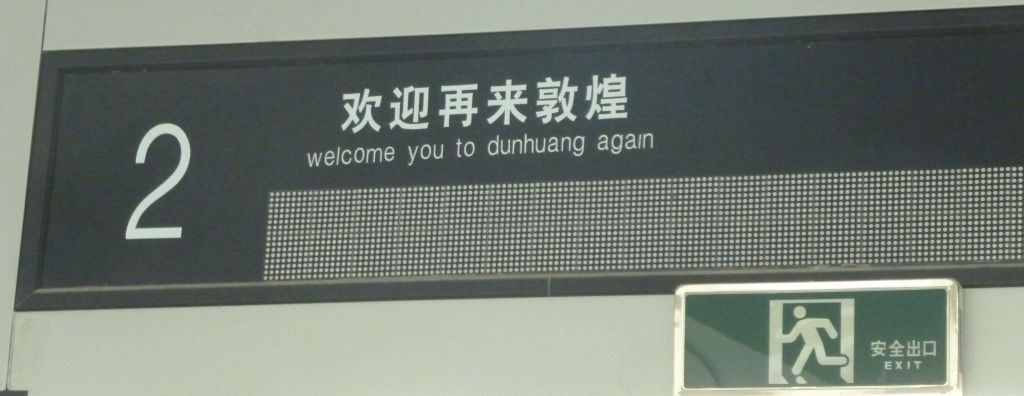
This means crossing the desert; well, actually the tarmac which never seemed so much in the desert.

Autostich failed to create a straight horizon, so this is a hand-made panoramic picture.

At the foot of the aircraft


There is really nothing noteworthy beyond the aircraft

Boarding ; the ground staff is wearing a hat to avoid tanning.

Sorry, the first ideogram is missing: I was too close, or the focal length of my camera was not short enough. I hate cutting a word like this.

There it is, with the Skyteam logo too.

This time, I show you the single seat of the seats in 2+1 in J, because passengers were already seated on the other side.
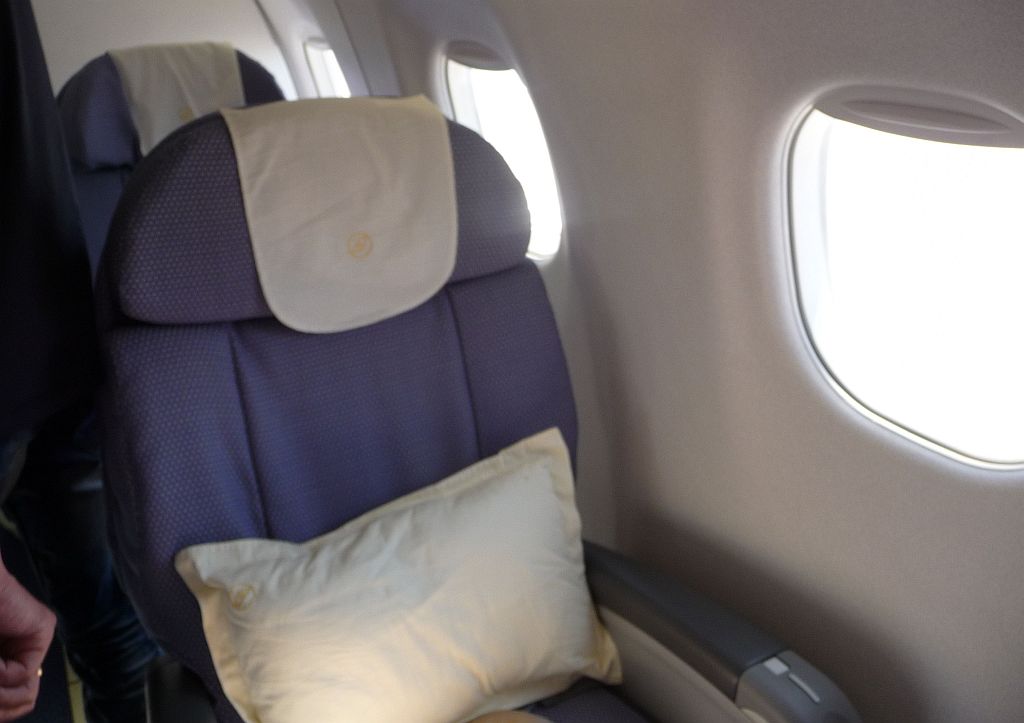
When we reached our row, the couple which should have been one behind the other aisle-side had already anticipated our common wish to travel next to each other, and took one row : everybody is happy about it.
The tarmac is always as empty, through a not very clean window.

Departure of the mobile stairs, in contre-jour.

The inside of the cabin.

Ready to take off from runway 08. It is really a desert landscape.
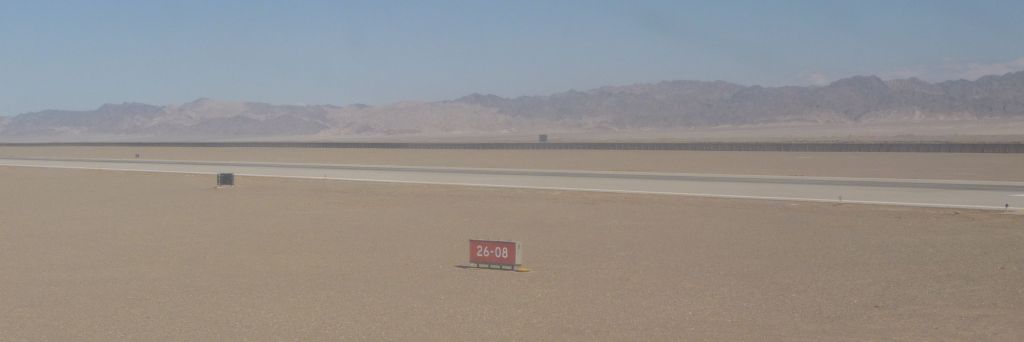

A view of DNH after the turn to head west.

This wider view provides an interesting feature of DNH. Look at the white lines crossing sideways in the desert, beyond the runway. No, these are not trails, but levees. Levees in the desert?
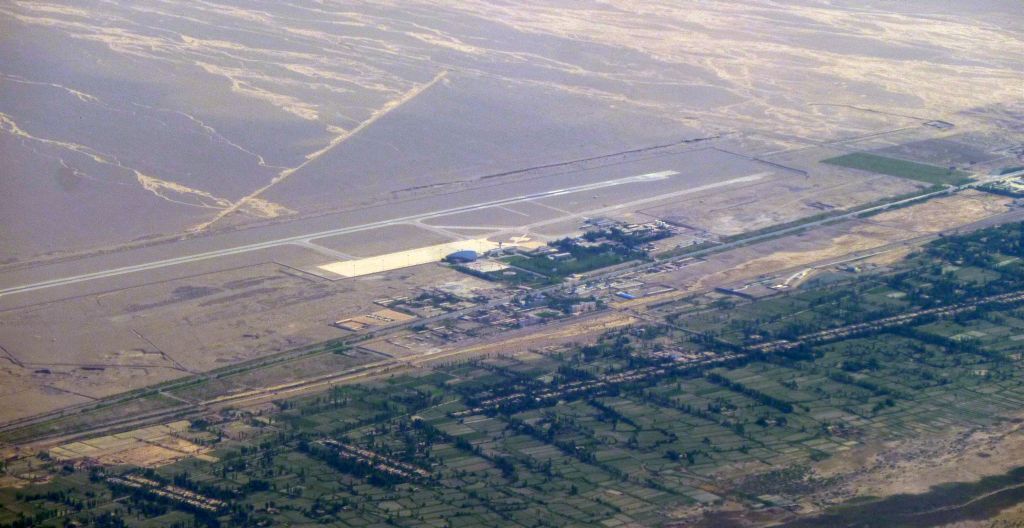

A desert is not necessarily a place where it never rains like in Turpan, but can also be a place where the scarce annual rainfall is concentrated in a limited number of storms. Look at the wadi beyond the airport: it is a danger for the runway.

A danger, really? Sure! Two days before we landed, such a storm occurred on the mountains south of Dunhuang. The water rushed down the slopes, and the water level went up one meter above that bridge, under which there is usually no water at all.

This bridge held – it is the one which provides the only access to the world famous caves of Mogao which are in the background. On the other hand, a few kilometers downstream, two arches of that other bridge were washed away. The cars were using a makeshift ford bulldozed by PLA (People’s Liberation Army) men and equipment, when we visited the caves. The day before, they were unreachable, and they were the sole purpose for spending 5,000 RMB round trip for the flight and accommodation for both of us.

This sums up Dunhuang: the oasis, the rock desert, the sand dunes, and the risk of disastrous flash flood.

Desert with sand dunes
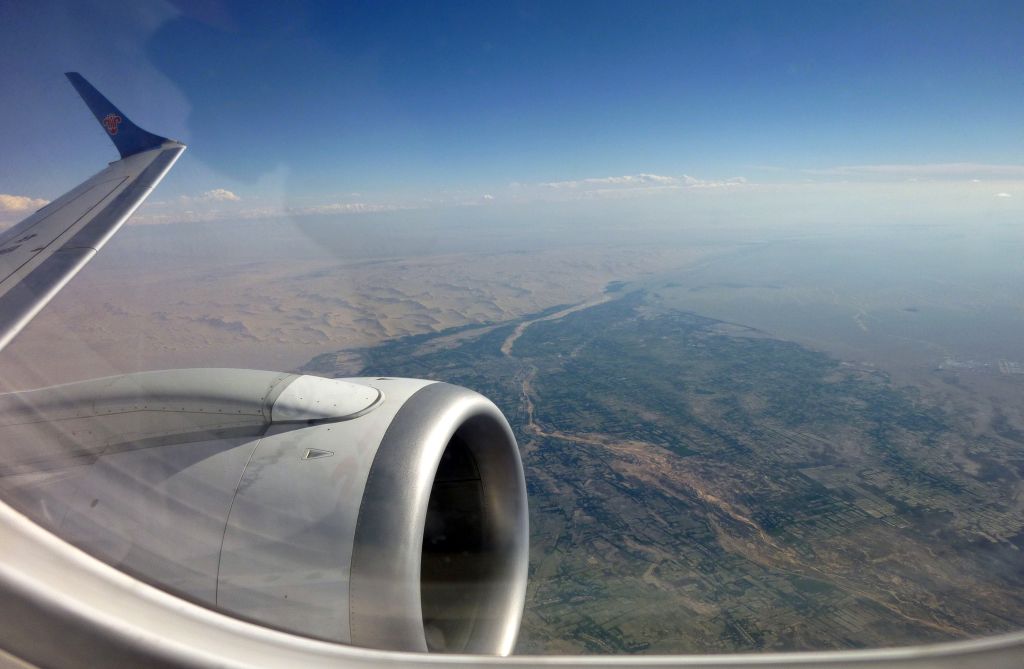
And desert without sand, therefore without dunes.
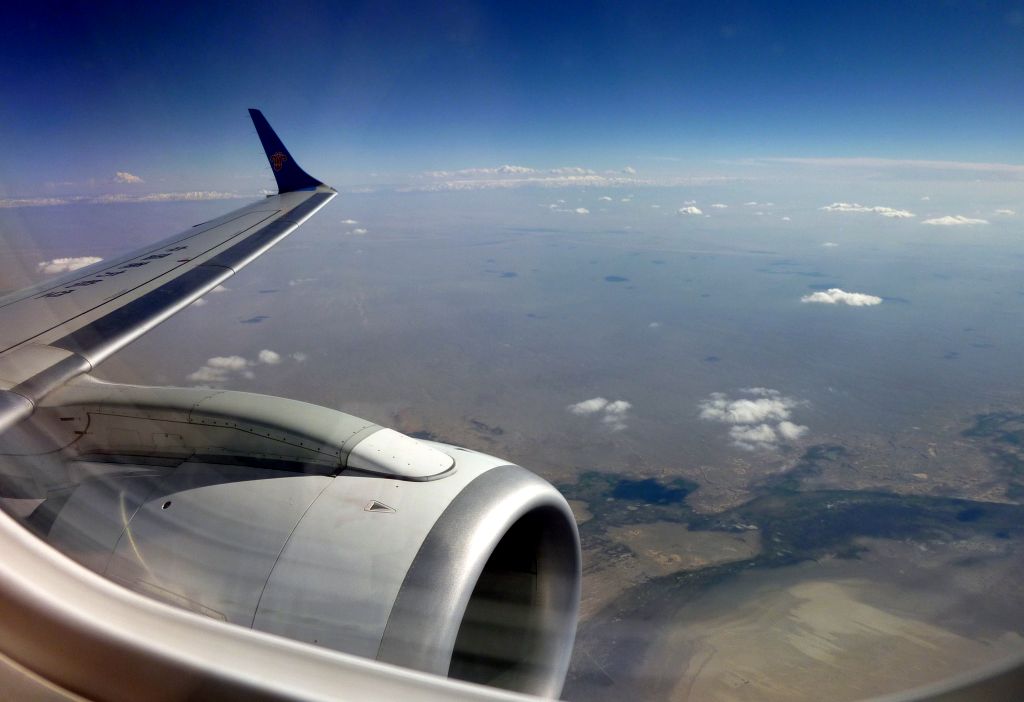
And a winglet.
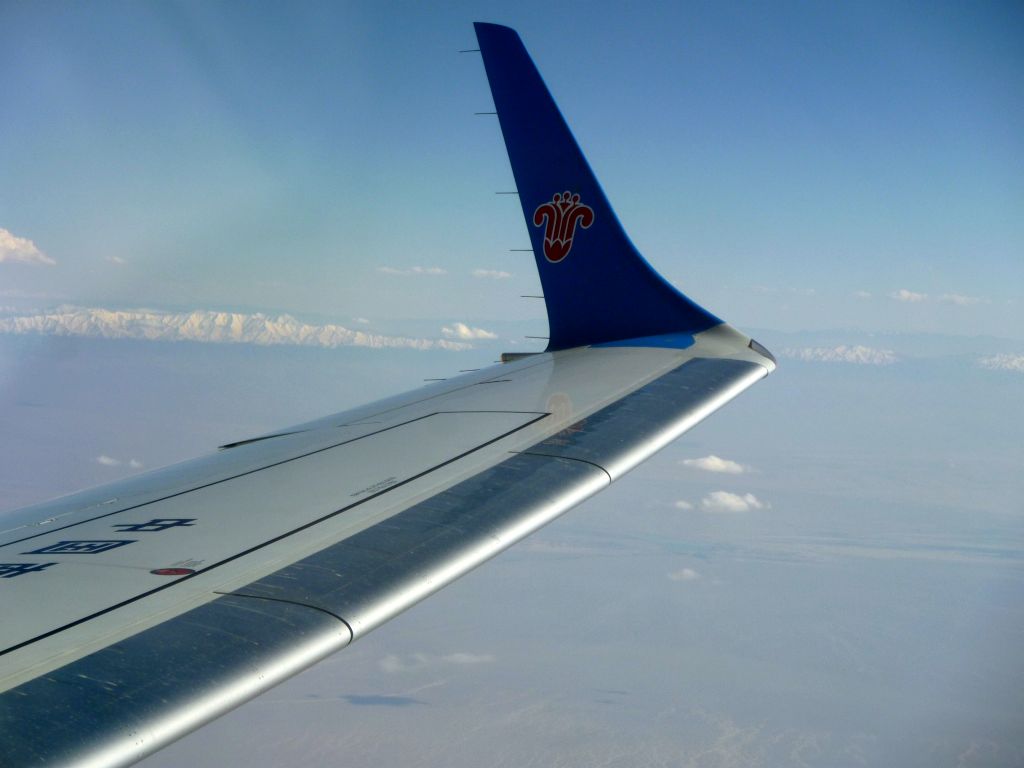
The flight attendants distribute a light meal. I masked the eyes, but look at her nose: this woman is obviously not Han, but most probably Uyghur, the majority nationality in Xinjiang.
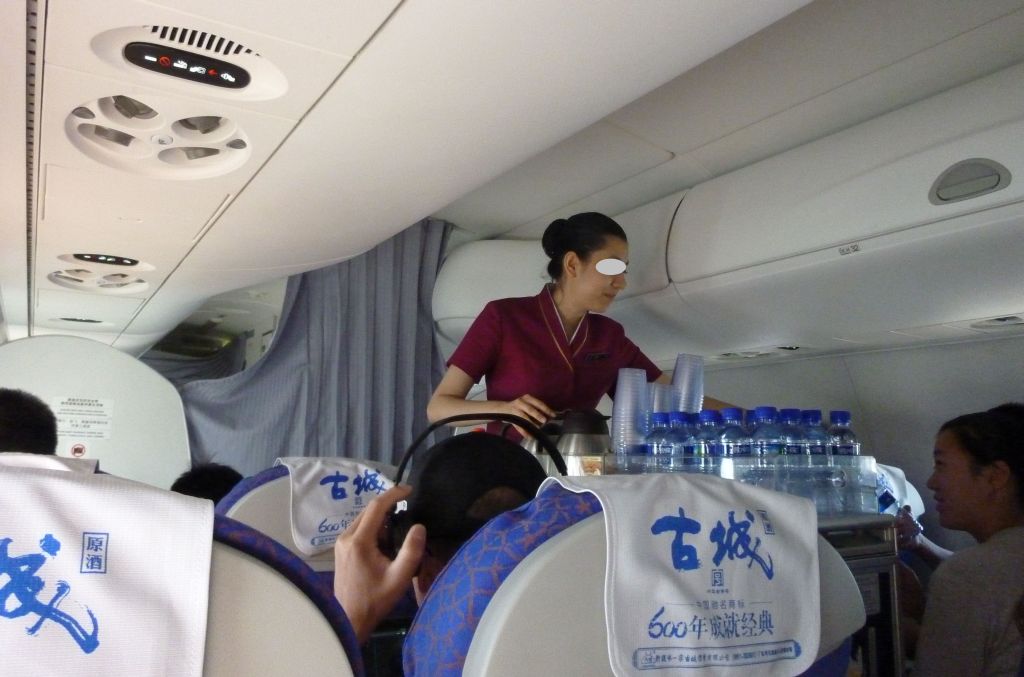
A cardboard box and coffee, with milk but rather good.
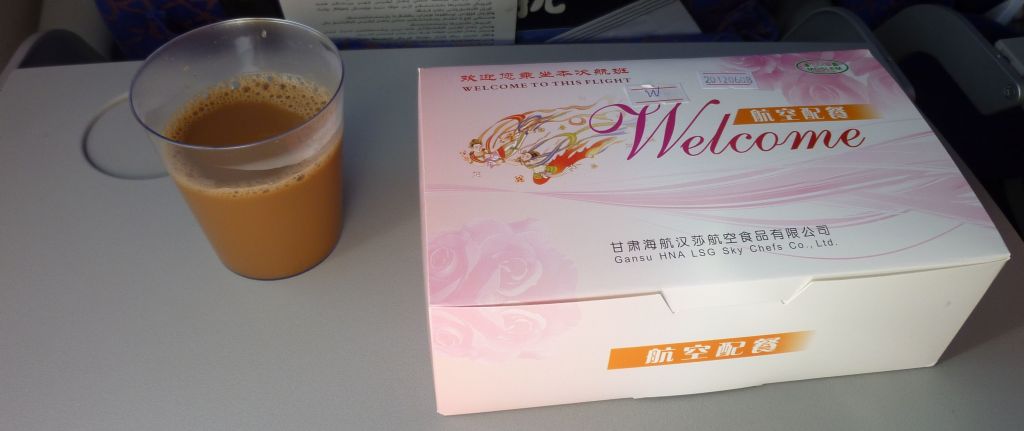
The decoration of the box is an interesting religious synthesis: it was sold by a company based in Gansu province, which is Buddhist, and decorated with a beautiful apsara (the equivalent of an angel), but its contents is guaranteed halal.


By the way, at the breakfast at our hotel in Urumqi the next morning, there was a warning for those who are not used to seeing haram food.
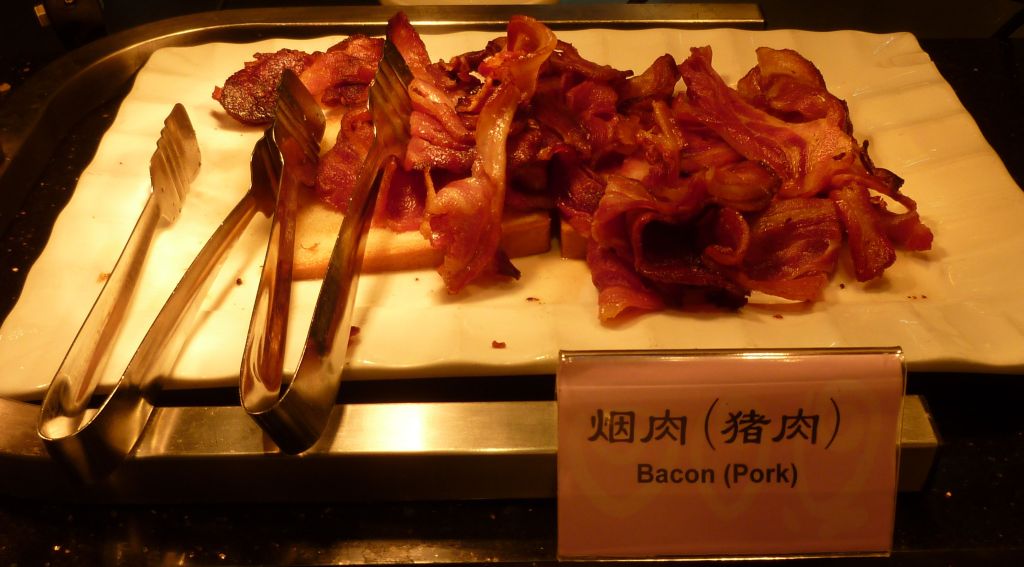
The contents of the box are somewhat unusual: two pieces of peeled cucumber, a small bread and 7 grams of butter.

Spreading the bread required some creativity: the passengers use one extremity or the other of that flexible plastic fork, with no clear advantage of either choice.

Plastic knives are probably considered to be too dangerous in this region.
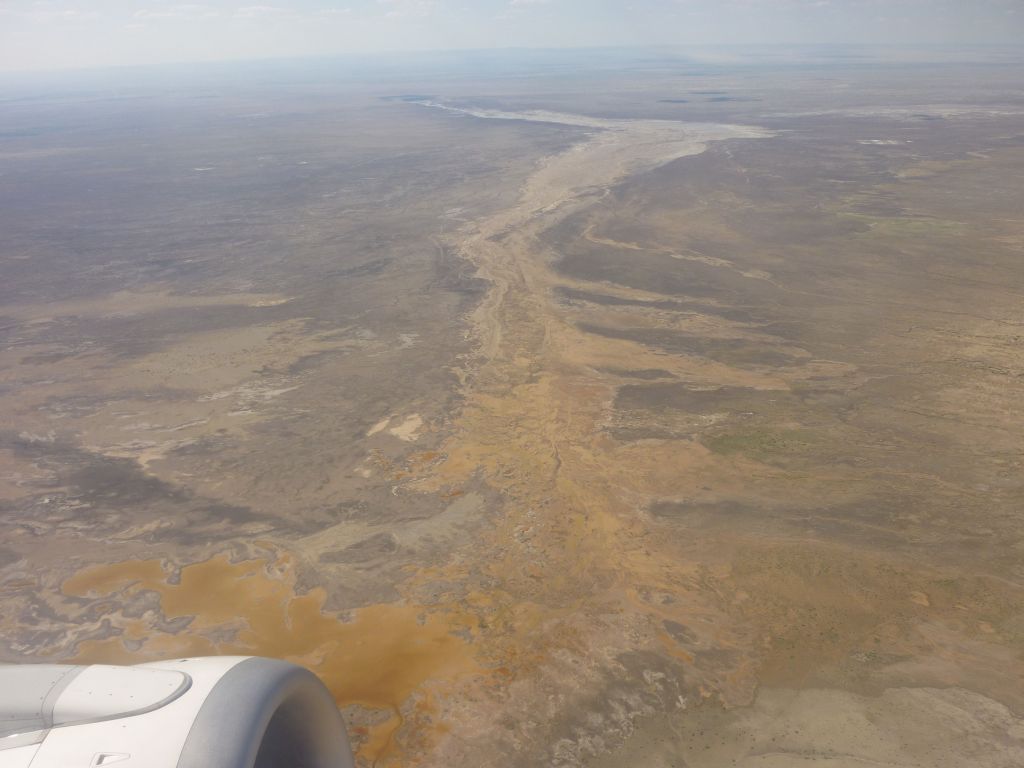
The landscape was desert, more desert and desert only. I sometimes enhanced the contrast or the colors, but my software is not very flexible.

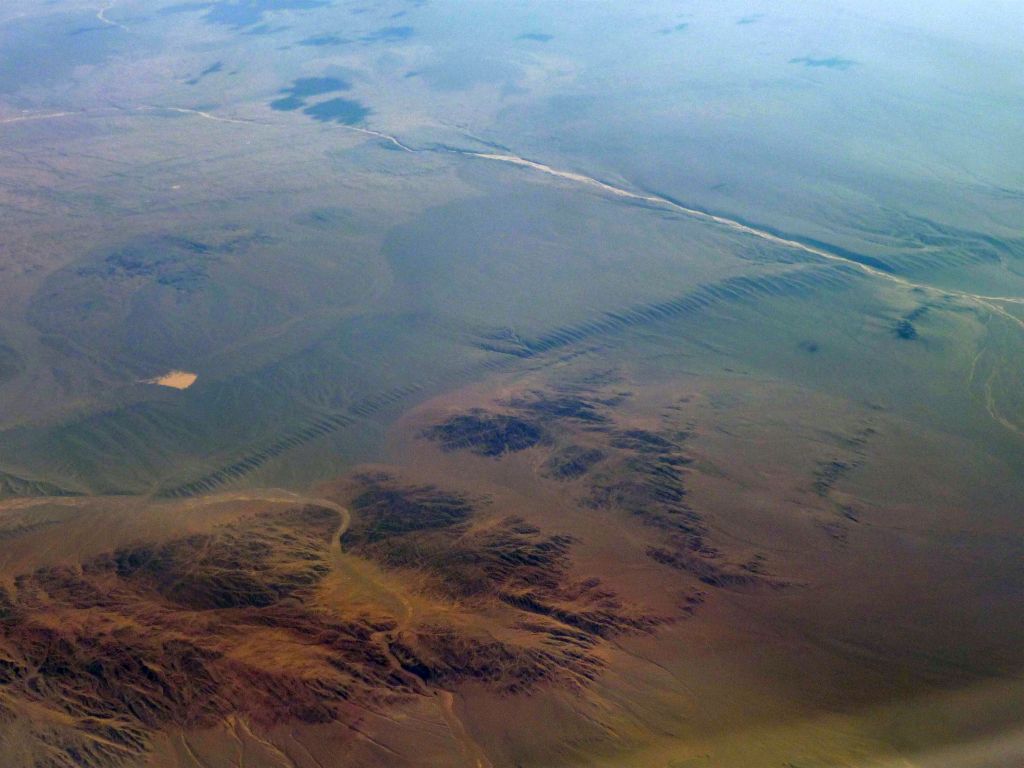
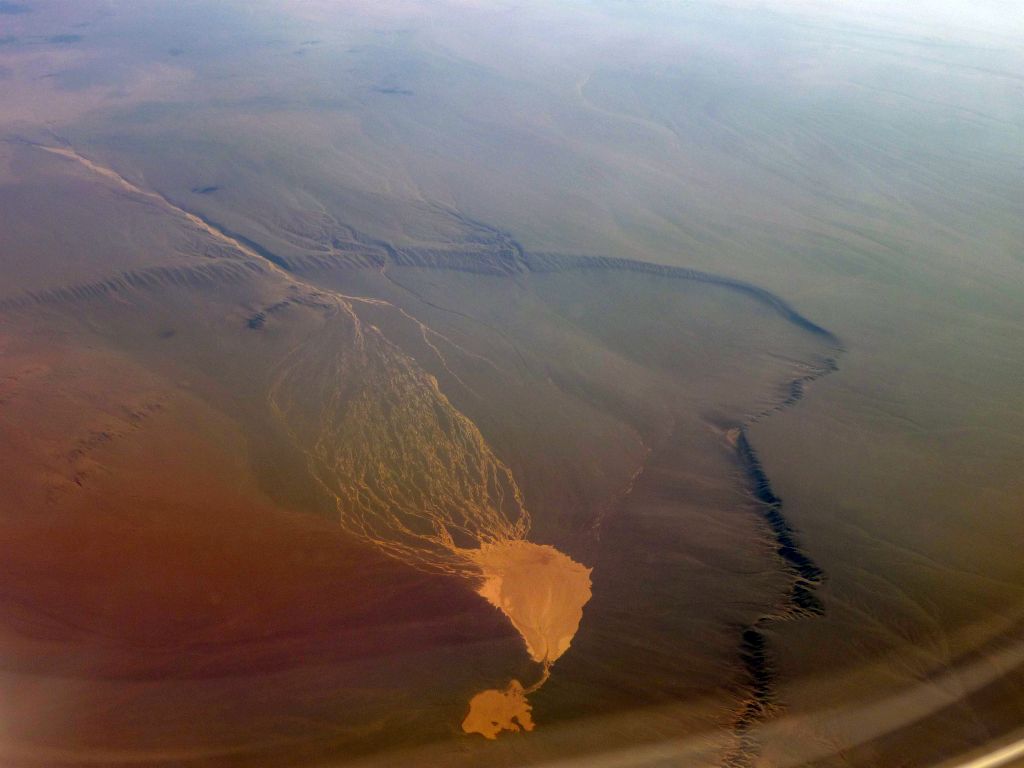
A winglet to remind the reader that it exists.
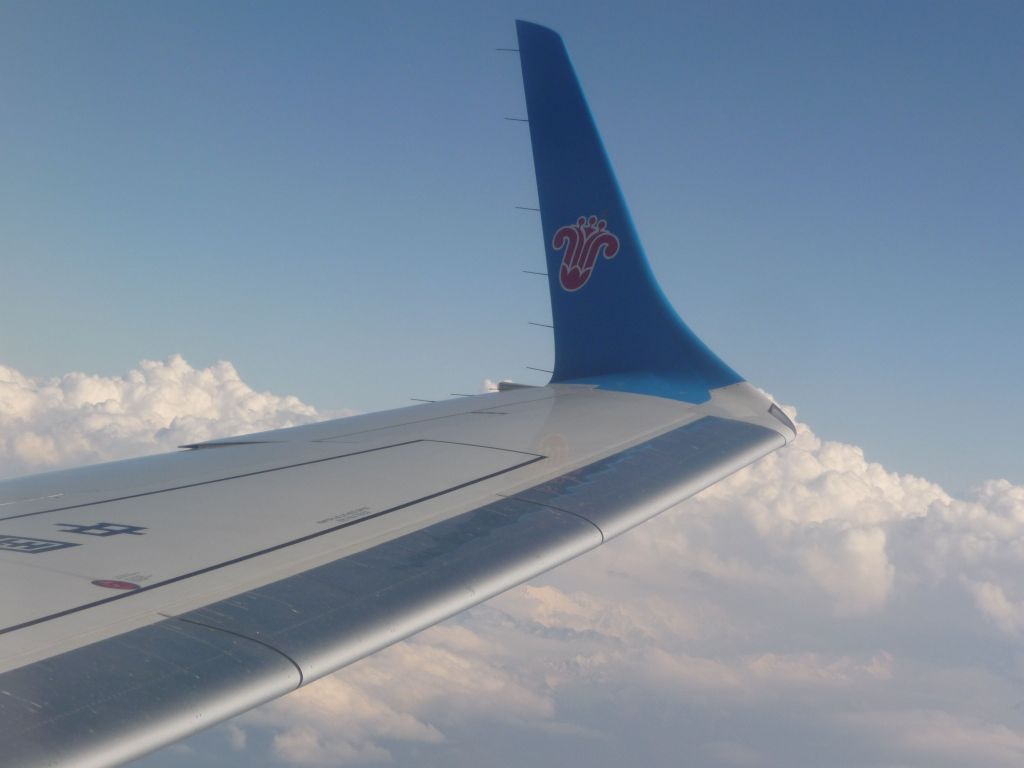
And then we reach the mountains bordering the south of the desert where Urumqi lies. The Taklamakan desert lies on the own south side of these mountains.

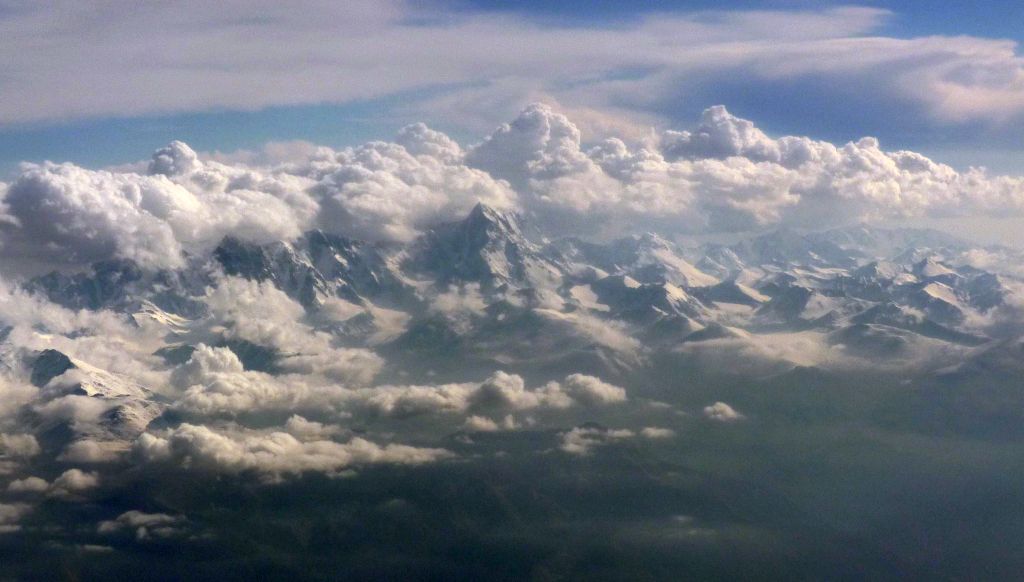

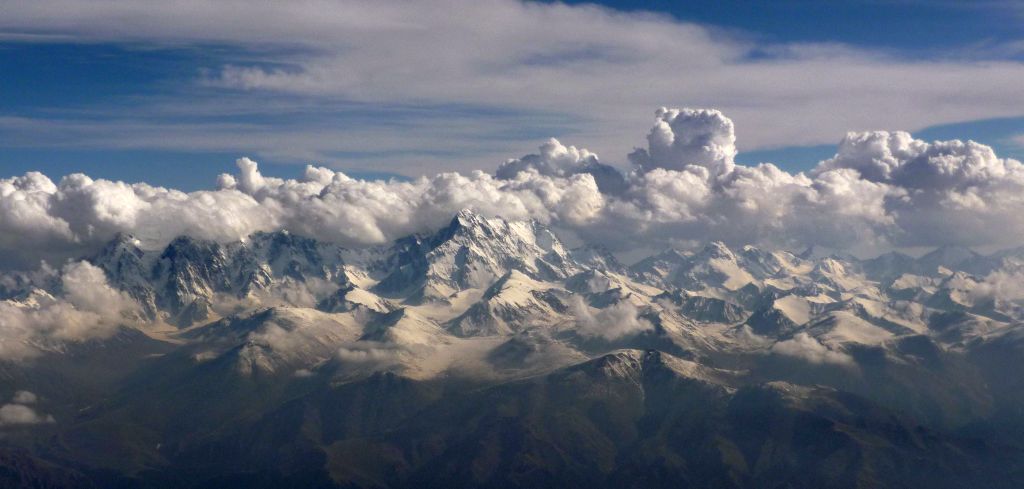
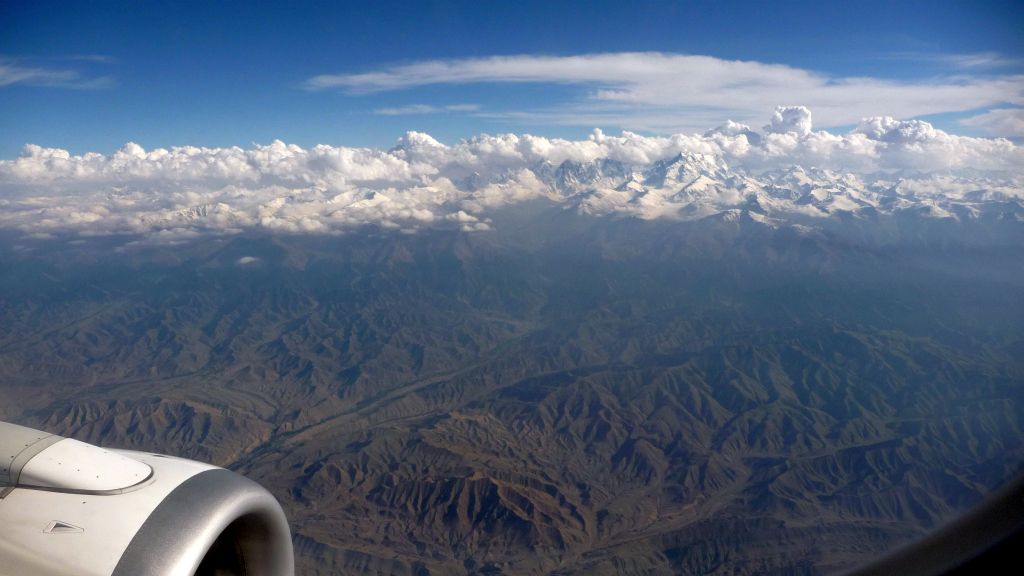


This is the end of the mountains; we start the descent towards Urumqi


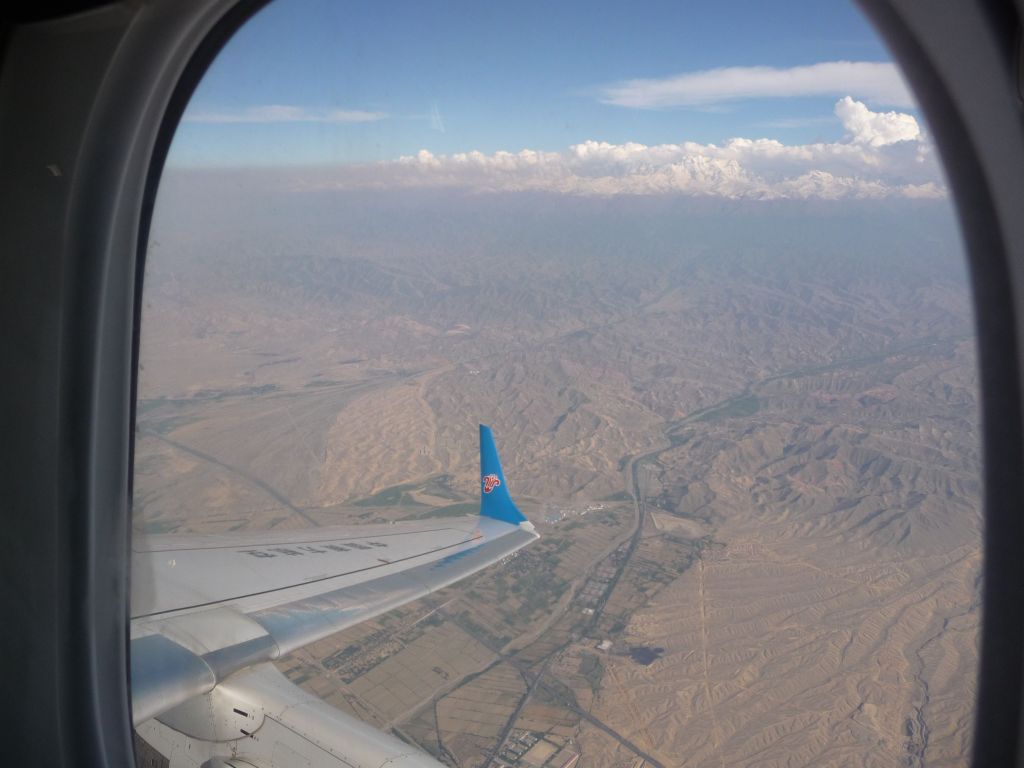
A valley, like a knife cut in the mountain

Focus on the dam for irrigation which provides its water
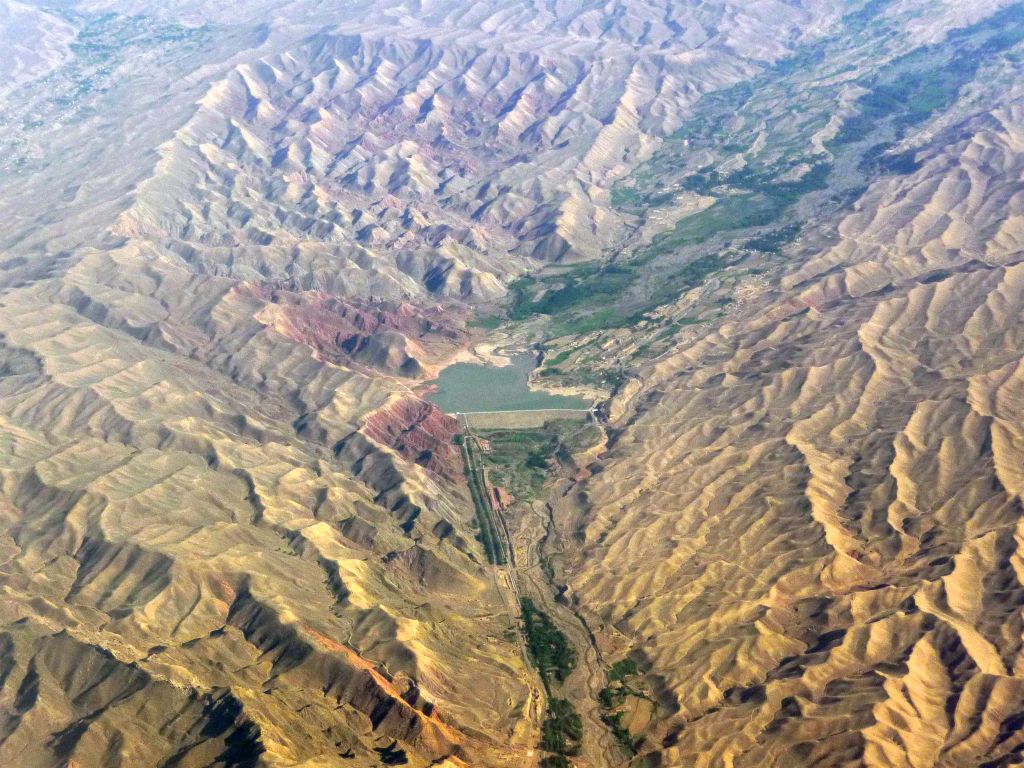
An economic development zone at the periphery of the urban sprawl.

The orientation of the main road of this old village did not correspond to the master plan of the developers. No problem, they destroyed the houses which were on the way of the new road. The compensations probably did not amount to much.

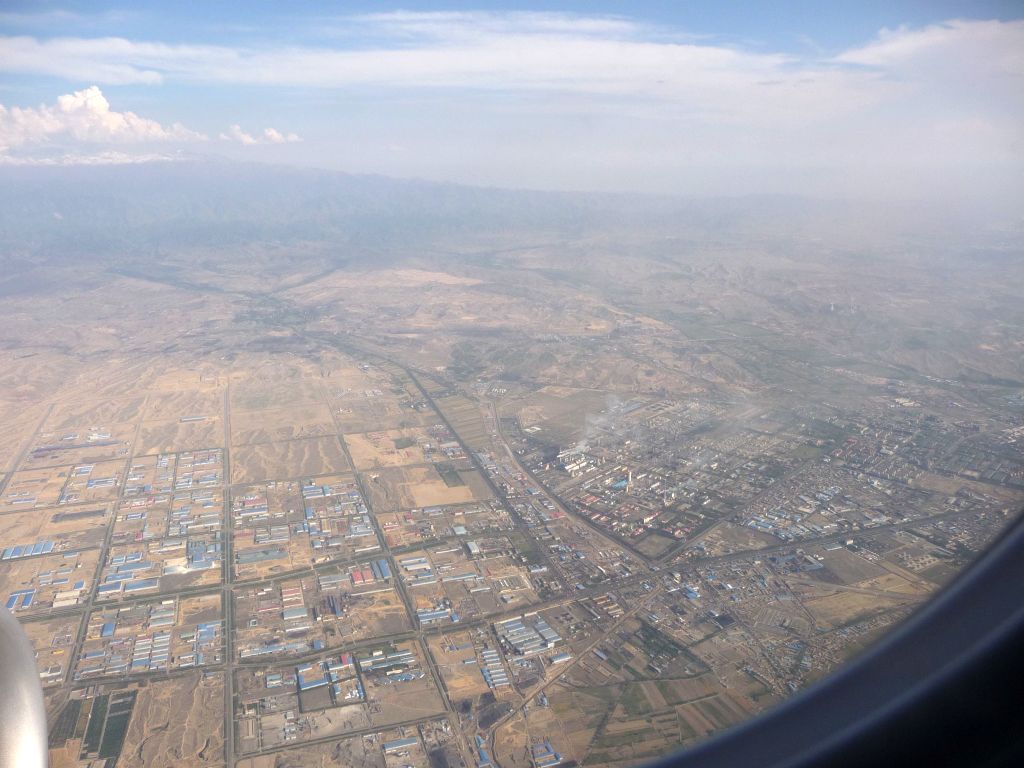
Developing Urumqi to make a major city out of it require energy, and therefore power plants. They probably run on oil, which is in vast quantities under the surface of Xinjiang, as opposed to coal elsewhere in China.
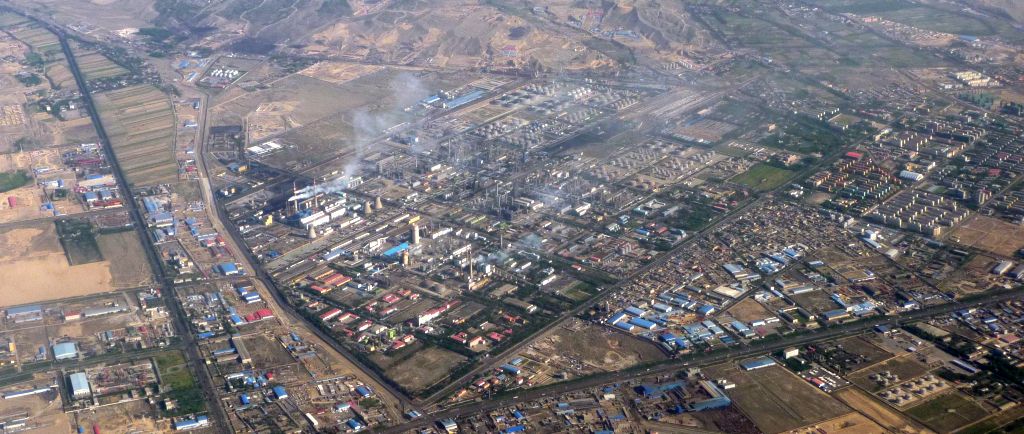

A piece of the soulless modern areas of Urumqi.

We are not here to talk urbanism, but air travel, and this is therefore the airport of Urumqi, that our plane will fly by and turn back to land in the opposite direction.


A close up

Focus on Terminal 2 in the foreground (a long ordinary rectangle), and Terminal 3 in the background, with its main hall with a curved roof with two branches on the right. An aircraft is ready to take off on the runway.

It is aloft a few seconds later, in the center of the picture

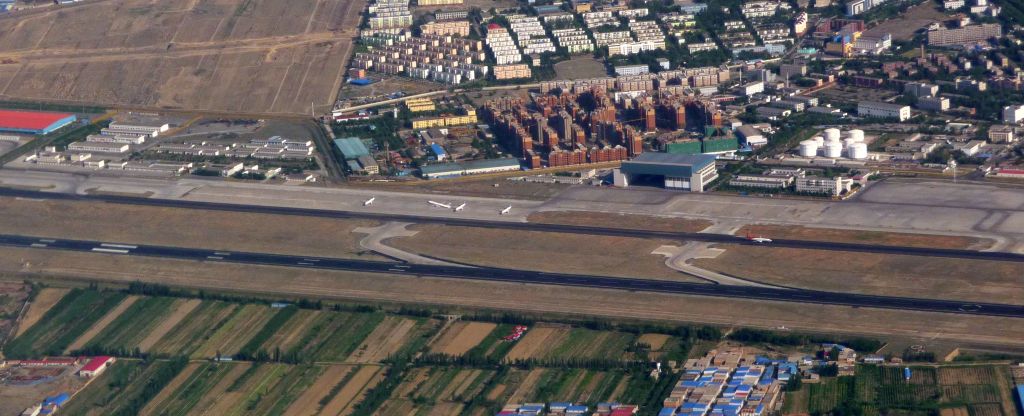
We fly past URC and are again in the countryside
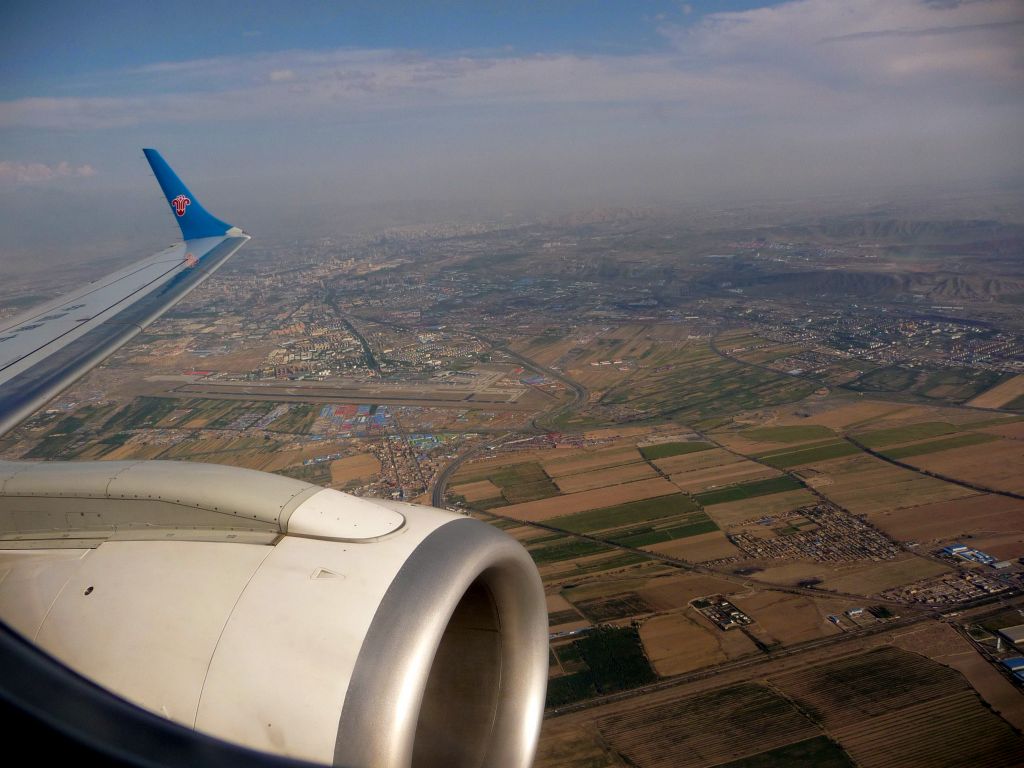
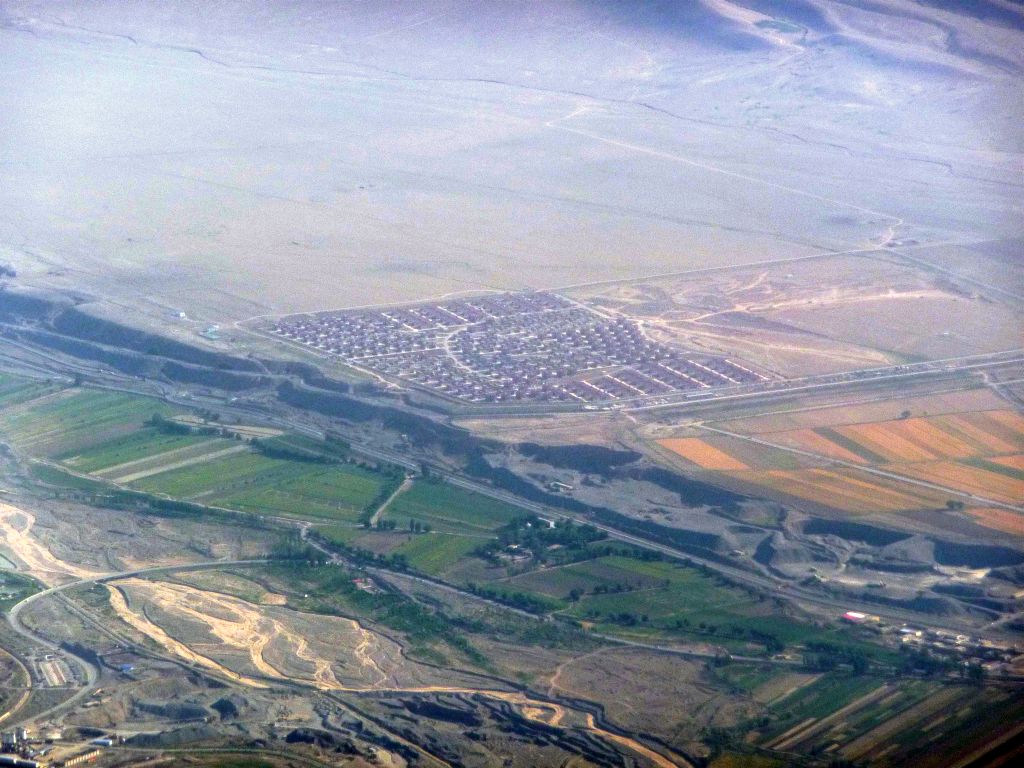
A bigger camera would have been better here, but I am nevertheless quite pleased with the picture of that aircraft in final to URC

A high wing four engine jet aircraft: since it really does not look like an Avro 146, and unless somebody disproves me, this appears to be an Iliouchine 76, an aircraft that I have never seen so far in the Chinese airspace or on their tarmacs. At this time, there is a SU flight from Moscow, but it is usually operated with a 757, and I guess this is a cargo flight.

It flies here above industrial installations close to the airport.

The same buildings or nearly so, after enhancing the contrast. I do not know what the four domes on the left could be.

Our E-190 reaches the desert and turns around.


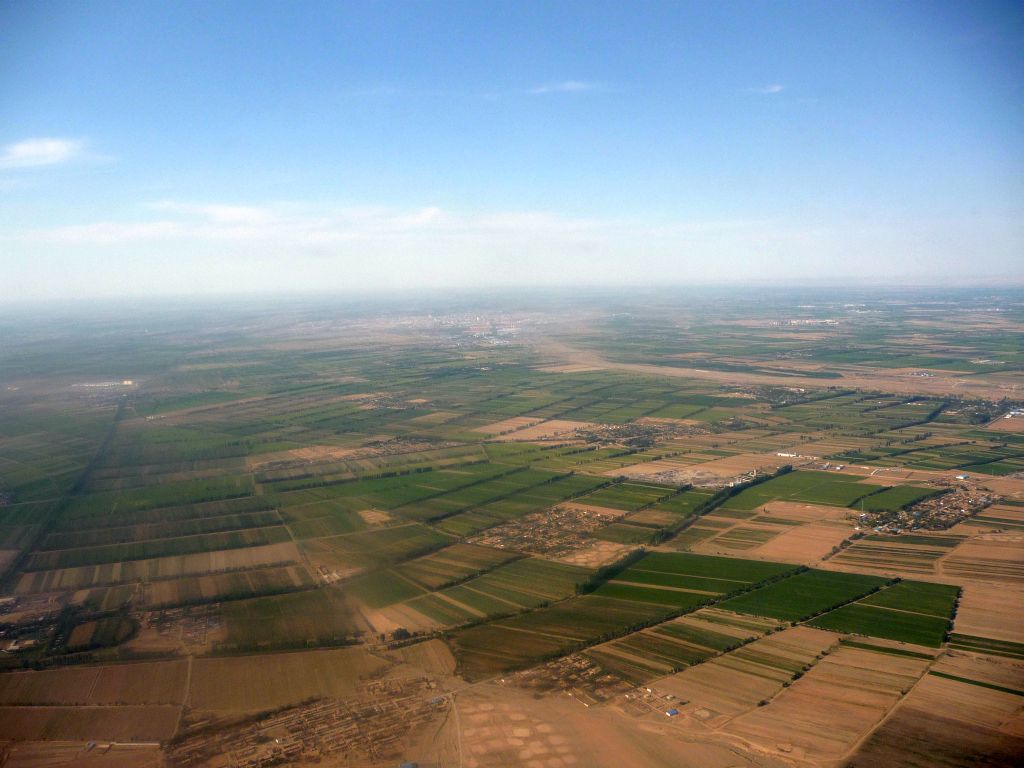
The limit between cultures and desert

We are now flying back to URC: these are alignments of greenhouses like everywhere in China.
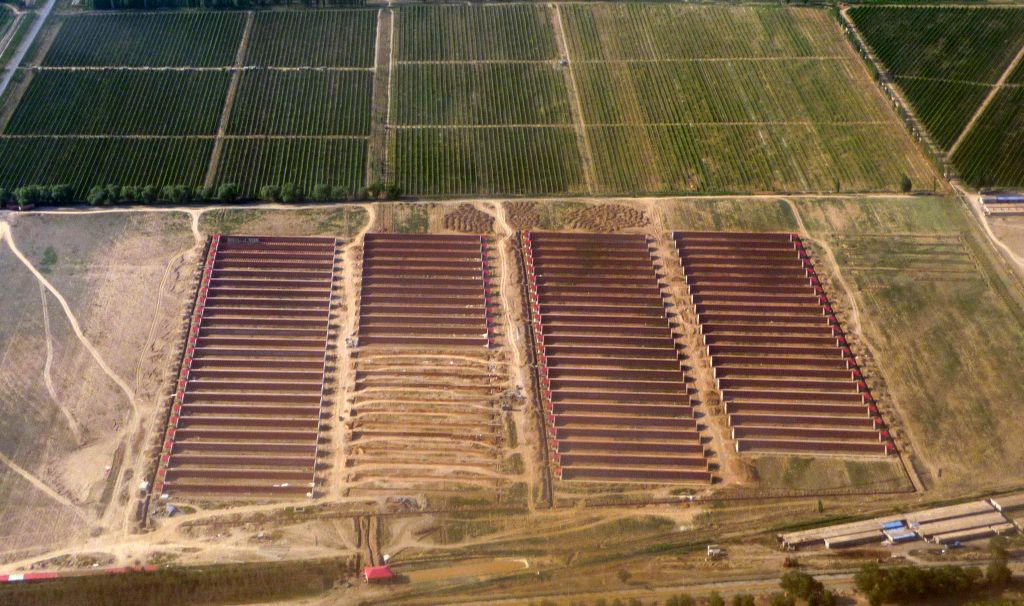
A rectangle of typical Chinese housings
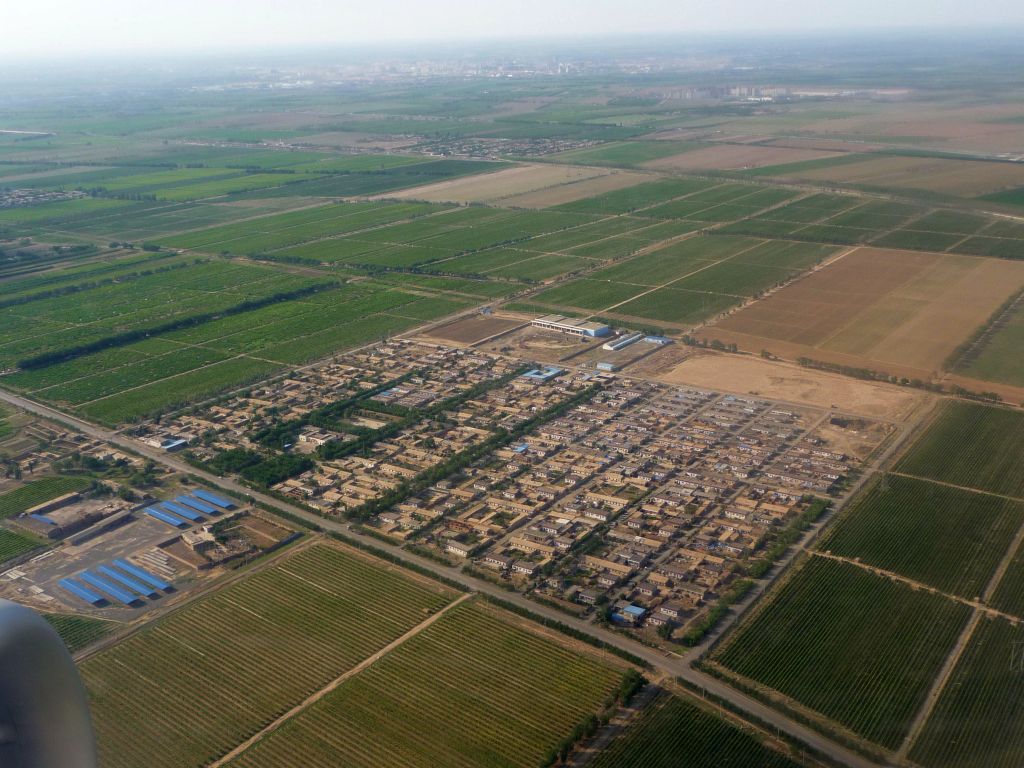
This view too is typical of Mainland China: alongside a major highway, you can see a row of truck repair shops, which is the quasi-continuous red-roofed building. Each shop is specialized in a given type of maintenance and can handle a single truck at a time. There are many of them; some were moving when the picture was taken. In parallel, the buildings with white terrace roofs are the housings for those working there. I once saw a similar alignment which was three kilometer long.
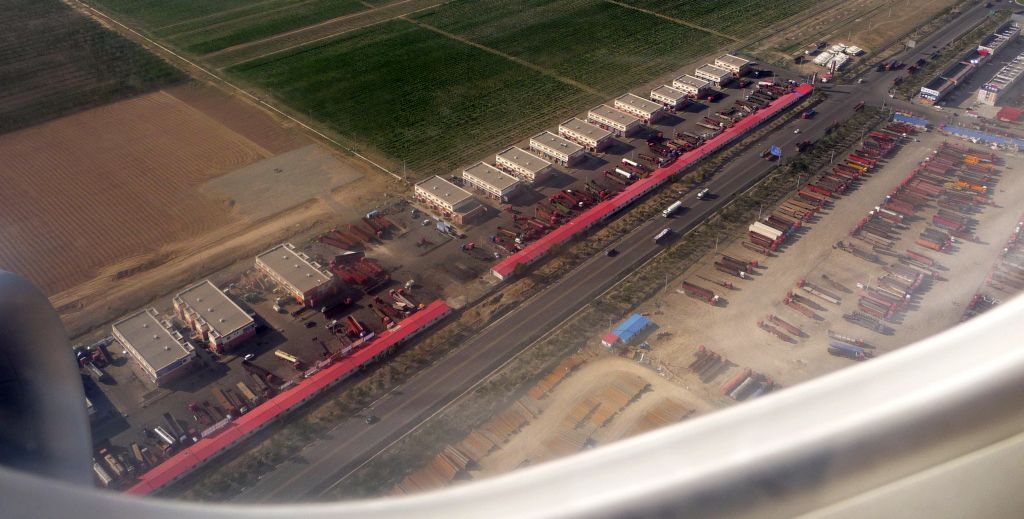
Touchdown and thrust inversion
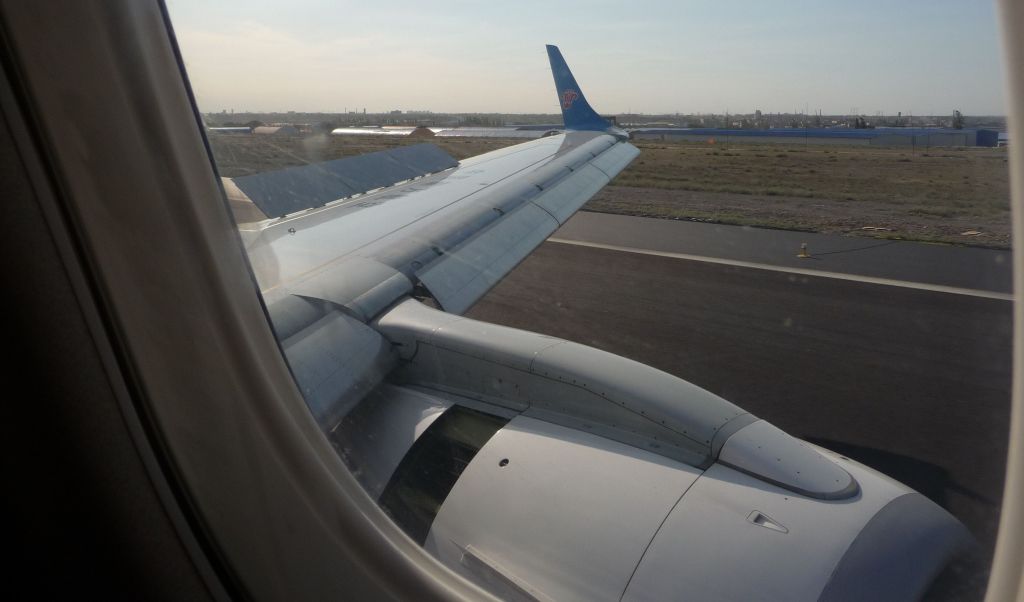
Another tour of URC, because the aircraft stopped beyond Terminal 1 below, and we must reach Terminal 3.

The pointed roofs are for decorative purposes only.

Again the Tianjin Airlines Embraers

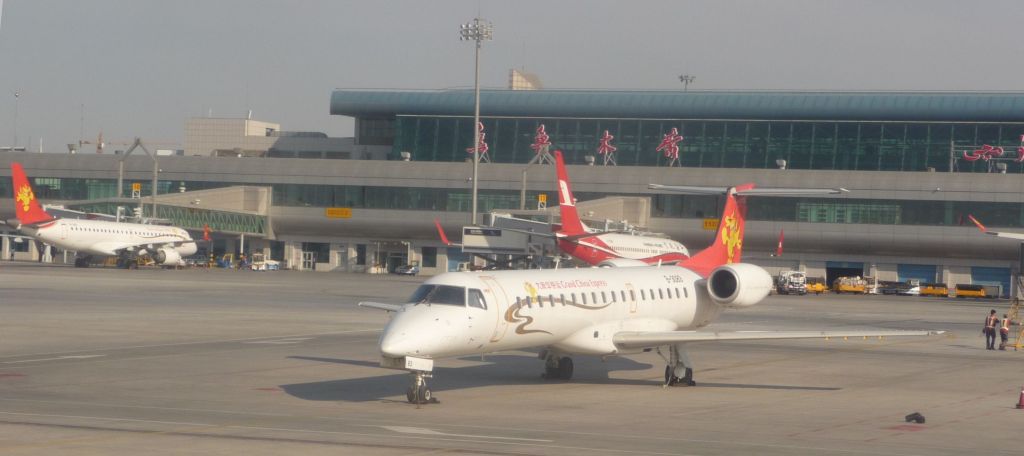


The airside face of Terminal 3

And arrival pier-side next to another E-190.
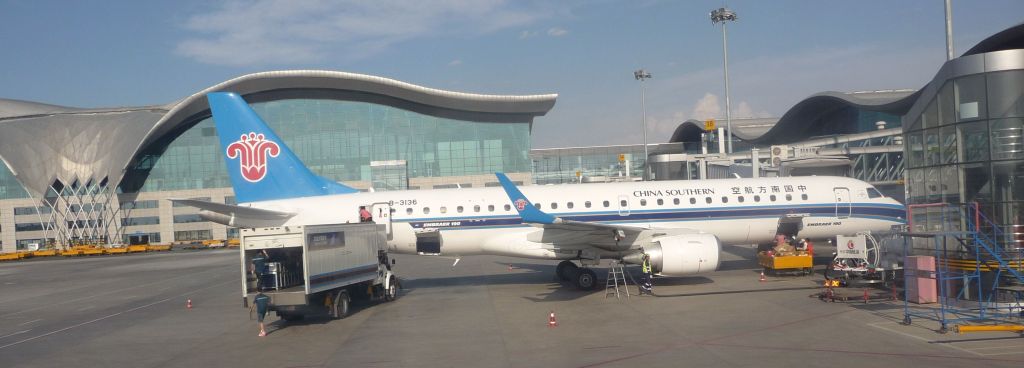
HSBC does not decorate the Chinese jetbridges. Here, it is the Bank of China, which celebrates its 100th anniversary.
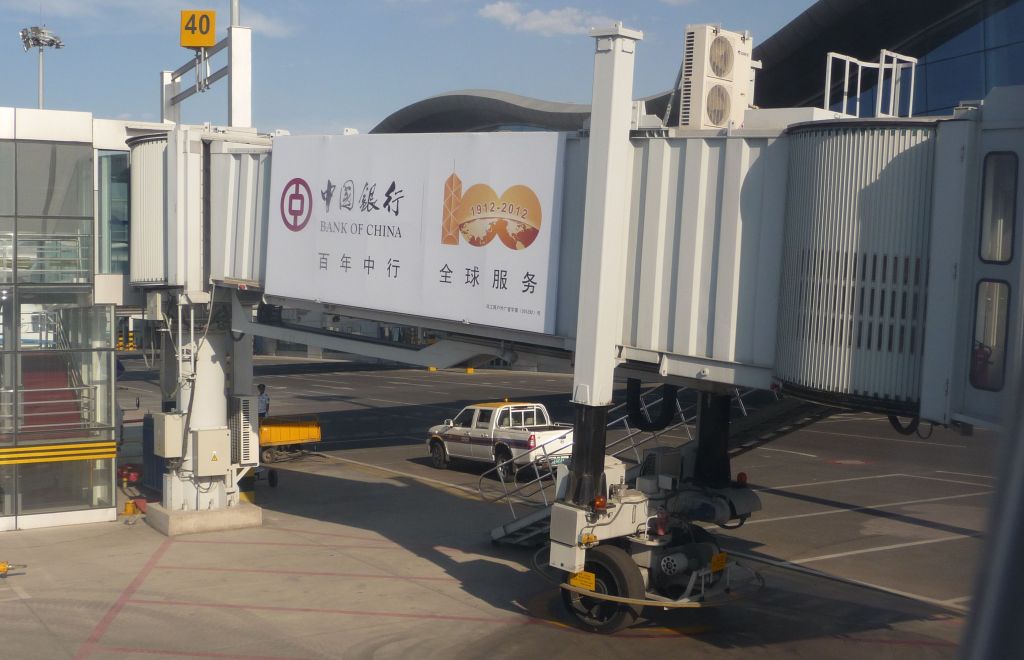
Good news for Skyteam addicts: Sky priority is implemented in Urumqi too.
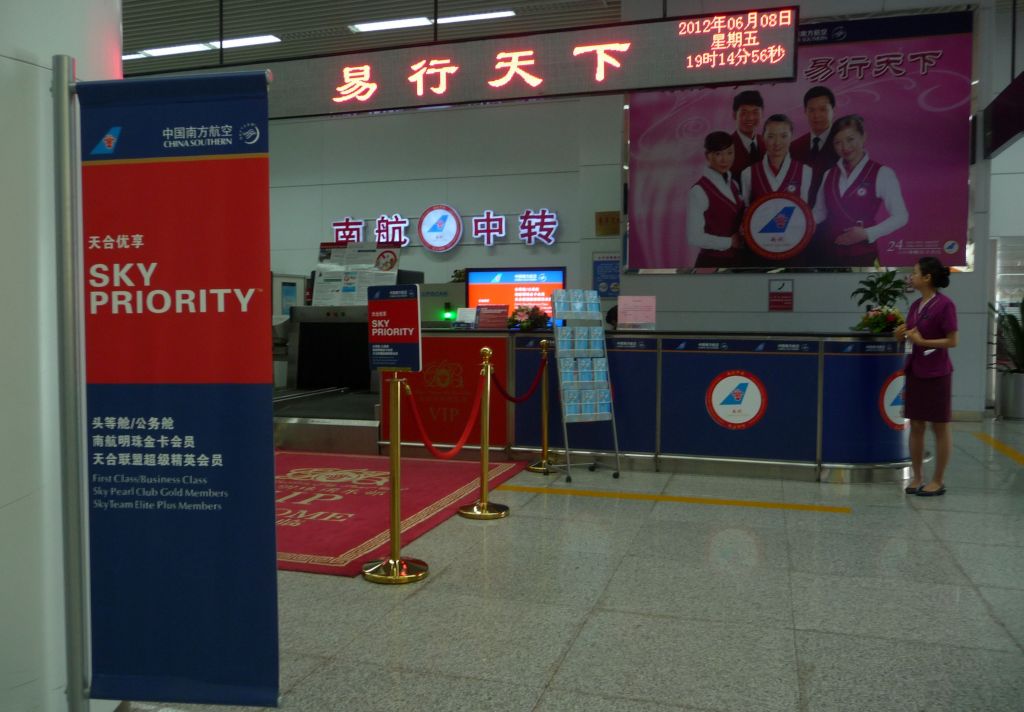
The list of connecting CZ flights. Dream destinations, or destinations that you never heard of, even in your dreams?

Red carpet welcome for luggage delivery chute for priority luggage, that we did not know about when we first landed in URC.

This time, we are only FB-Silver passengers in economy on a domestic flight, a nobody status which makes us wait for our luggage at the rank and file Number 1 delivery, observing this « warm tip » which is a very common translation error in China. Delivery is a little bit slow to start, but our luggage is among the first out.




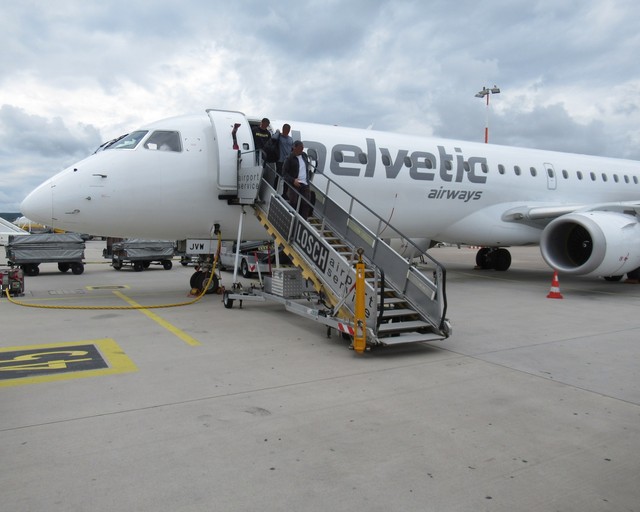

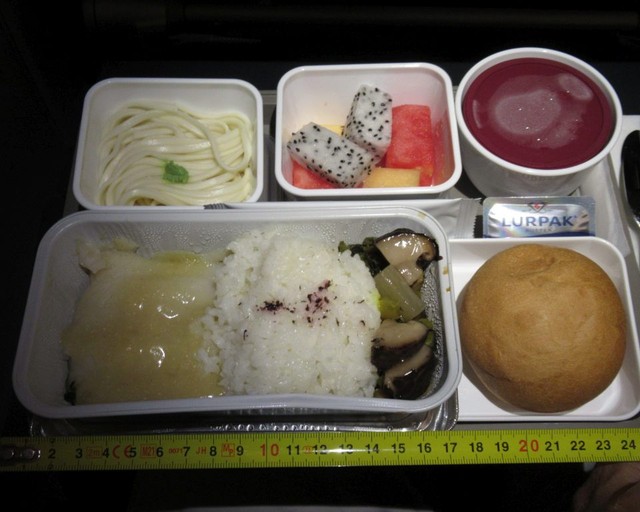

Marathon, thanks for sharing this great FR. I especially liked the beautiful pic with passengers walking to the E-190, through the desert...
Did you ask the Halal food box or that was the standard meal?
I agree with you, the white plane is a Il-76
I took a similar picture in HTN (re. my report on HTN-URC). I have been fascinated by these airports in the desert - they are so far away of your conventional idea of a Chinese airport.
There was no choice of food on board - it was halal for all. Thanks for your comment :)